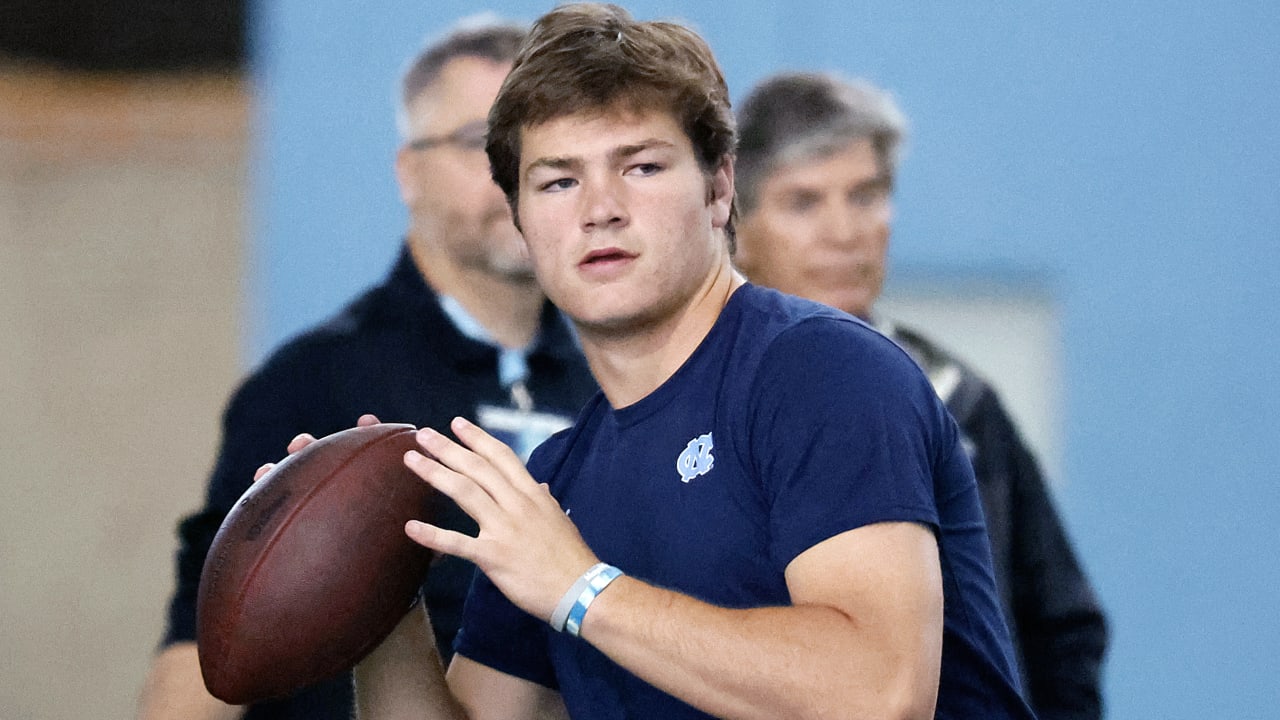When the Patriots selected quarterbacks Drake Maye and Joe Milton in the draft last April, a few scouting philosophies were worth discussing with the two rookies.
The first takeaway was that personnel chief Eliot Wolf is moving away from the cerebral pocket passer archetype that New England typically targeted in favor of physical tools/upside. Maye stands at over 6-foot-4, 223 pounds, while Milton is a 6-5, 235-pound monster. Both first-year quarterbacks have great arm talent, size, mobility, and exceptional raw talent—certainly, a much different skill set than former first-rounder Mac Jones or fourth-round pick Bailey Zappe.
Although their physical tools are undeniably enticing, the potential downside was that Maye and Milton were raw talents who could have an extended developmental career arc. Maye’s footwork, throwing mechanics, and timing in North Carolina’s offense were picked apart during the draft process. His highlight throws were as good as any draft-eligible quarterback, but the 21-year-old’s college tape was inconsistent.
Maye still had plenty of support in the draft. But there were constant debates about a potential redshirt season or even bringing him along slowly, like Packers QB Jordan Love. With Wolf’s history in Green Bay, the Patriots top personnel exec might subscribe to sitting young quarterbacks, and that was further reinforced by the team signing veteran Jacoby Brissett.
Adding more fuel to the fire that Maye could sit for an extended period was that he only played six total snaps, one drive, in his preseason debut on Thursday night. Compared to other high draft picks in recent years, Maye’s lack of playing time in the win over the Panthers was an anomaly. Then, Milton made waves on his eight drop-backs, uncorking a laser on a 38-yard touchdown pass and running for 25 yards on two scrambles in the second half.
Milton’s impressive debut and Maye’s limited workload have caused a mini-stir about how head coach Jerod Mayo and his staff handled the quarterbacks in the preseason opener. We’ll leave it to the talking heads to argue over snaps in a preseason game. From this perspective, the coaching staff deserves kudos for their work with the two rookies.
As mentioned, Maye and Milton’s talent is undeniable. But offensive coordinator Alex Van Pelt and quarterbacks coach T.C. McCartney deserve credit for how far the Pats rookie QBs have already come in the nuances of the position. Although there were only 11 combined drop-backs, Maye and Milton are showing early signs of improvement. Their footwork, particularly from under-center where they’re inexperienced, was clean. They threw in rhythm and made good decisions. It was a solid, albeit brief, first taste of what they have to offer in an NFL game.
The Patriots will host the Eagles for a joint practice on Tuesday, then have two more preseason auditions, during which the rookies are expected to play more. As the future of the franchise, Maye has earned the opportunity to get more live reps with New England’s starters, and Coach Mayo told reporters that Maye will likely play more next Thursday night.
Although it’s premature to say Maye might not need to sit behind Brissett, the third-overall pick is making strides with his mechanics and decisiveness in the offense. Wolf gave Van Pelt’s offensive staff two project quarterbacks to develop with a long-term view, and the early returns suggest that Maye and Milton are getting good coaching.
Here are other key takeaways and quick-hit film notes from the Patriots preseason win over the Panthers After Further Review:
1. Initial Reviews on the Patriots Zone-Blocking Run Scheme
Another element to the Patriots hiring Van Pelt as their offensive coordinator was a shift in approach to an outside zone-based run system in the running game.
Historically, the Patriots were a downhill, gap-heavy offense. However, Van Pelt comes from the wide zone system in a traditional West Coast offense. On Thursday night, New England ran 12 zone runs compared to 11 gap plays, a more balanced approach than expected. Still, we saw plenty of inside and outside zone from Van Pelt, who also mixed in power and trap schemes.
Although the outside zone system with play-action concepts built off the stretch actions has proven to work at this level, questions arose about the Patriots personnel executing these run-blocking concepts. With a roster mostly built for downhill running, does New England have the offensive linemen and running backs to execute a more athletic play than traditional power/gap schemes? Well, here’s what the film from the top O-Line said.
Admittedly, it’s a tiny sample size of one outside zone run and a split-flow zone scheme with the top group. However, those runs went for one yard and -1 yards against backups for the Panthers. To be fair, there was a cutback lane forming for RB Antonio Gibson on the negative play, but LT Vederian Lowe fell off his block, leading to a TFL for Eku Leota.
The other run stuff for the Panthers spoke to some concerns about the Patriots blocking these schemes. This play is not pure outside zone. Instead, it’s called a split-flow zone, where the tight end works across the formation to account for the unblocked backside end. The back can still “bang” it through the front-side gap or cut back off the tight end’s block.
In the play, starting right guard Mike Onwenu has a defensive tackle over his outside shoulder. Along with right tackle Chuks Okorafor kicking out the play-side edge, Onwenu needs to overtake the B-Gap defender and turn him back inside to create a rushing lane. The other option is for Onwenu to create a cutback lane by blocking the three-technique into the sideline. As you can see, Onwenu doesn’t fully open the B-Gap, while tight end Mitchell Wilcox whiffs on the sift block, so Gibson has no choice but to take what he can get through a small crease.
The question mark as the Pats feature more outside zone was always whether their bigger guards, Onwenu (6-3, 344) and Sidy Sow (6-4, 323), could execute the reach blocks on the line of scrimmage to get the run game going. Ultimately, it’s two reps in their first preseason game, but it remains on my radar. The Pats should have a productive running game, but AVP might need to pivot to more downhill runs.
2. Patriots Flex Depth Along Defensive Front With 51.9% Pressure Rate
Although teams aren’t game-planning in the preseason, the August auditions are a good way to study New England’s base schemes on both sides of the ball.
In recent years, the Patriots defense has been a hybrid front system, with different early-down alignments and a pass-rush package featuring lighter personnel. For example, the Pats often based out of a 3-3-5 nickel defense where their base front was a 5-1 structure. On third down, they’d unleash their 5-0 rush package, which was highly regarded in the football community as one of the best rush packages in the NFL.





